|
|
#841 |
|
⊙▃⊙
|
Daily Suspicious0bserver's Weather Post:
February 16, 2014 What's in the sky tonight? February 16, 2014 -The thick waning gibbous Moon rises in the east around the end of twilight. Look higher above it now for Regulus. Extending upper left from Regulus is the Sickle of Leo. -A brief geomagnetic storm on Feb. 15th sparked by a CME impact has petered out, and the chances for auroras this weekend are subsiding. The CME appears to have been a merger of three minor clouds that, even together, could not cause a sustained disturbance in Earth's magnetic field. The hoped-for Valentine's display of auroras never materialized. -After days of nonstop activity, big sunspot AR1974 is quieting. The sunspot's magnetic field appears to be losing some of its unstable complexity, prompting NOAA forecasters to downgrade the chance of an X-class flare today to only 5%. Astro Picture of the Day: February 16, 2014  From afar, the whole thing looks like an Eagle. A closer look at the Eagle Nebula, however, shows the bright region is actually a window into the center of a larger dark shell of dust. Through this window, a brightly-lit workshop appears where a whole open cluster of stars is being formed. In this cavity tall pillars and round globules of dark dust and cold molecular gas remain where stars are still forming. Already visible are several young bright blue stars whose light and winds are burning away and pushing back the remaining filaments and walls of gas and dust. The Eagle emission nebula, tagged M16, lies about 6500 light years away, spans about 20 light-years, and is visible with binoculars toward the constellation of the Serpent (Serpens). This picture combines three specific emitted colors and was taken with the 0.9-meter telescope on Kitt Peak, Arizona, USA.
__________________
1st in Kommisar's 2009 SM Tournament 1st in I Love You`s 2009 New Year`s Tournament 3rd in EnR's Mashfest '08 tournament 5th in Phynx's Unofficial FFR Tournament 9th in D3 of the 2008-2009 4th Official FFR Tournament 10th in D5 of the 2010 5th Official FFR Tournament 10th in D6 of the 2011-2012 6th Official FFR Tournament FMO AAA Count: 71 FGO AAA Count: 10 Bluearrowll = The Canadian player who can not detect awkward patterns. If it's awkward for most people, it's normal for Terry. If the file is difficult but super straight forward, he has issues. If he's AAAing a FGO but then heard that his favorite Hockey team was losing by a point, Hockey > FFR PS: Cool AAA's Terry - I Love You An Alarm Clock's Haiku beep beep beep beep beep beep beep beep beep beep beep beep beep beep beep beep beep - ieatyourlvllol |
|
|

|
|
|
#842 |
|
⊙▃⊙
|
Daily Suspicious0bserver's Weather Post:
February 17, 2014 What's in the sky tonight? February 17, 2014 -Sirius now shines at its highest in the south around 8 or 9 p.m. Use binoculars to look for the dim open star cluster M41 straight below it by 4° (a little less than the width of a typical binocular's field of view). -Saturn (magnitude +0.5, in Libra) rises around midnight or 1 a.m. and is highest in the south at the beginning of dawn. By then it's far to the left of Mars and Spica, and less far upper right of Antares. -The shadows of Jupiter's four Galilean moons are not alike — or equally visible in small telescopes. These two were cast by Callisto (top) and Io, which aren't even the largest and smallest (those are Ganymede and Europa, respectively). Io and Callisto are, however, the nearest and farthest from Jupiter, so Io's shadow is always sharp and Callisto's is fuzzier. The fuzziness difference is evident only in superb images of Jupiter like this one, taken by Christopher Go at 12:16 UT February 6th. -Jupiter's orange Oval BA is nearly between the shadows, in the South Temperate Zone. South here is up.  Astro Picture of the Day: February 17, 2014 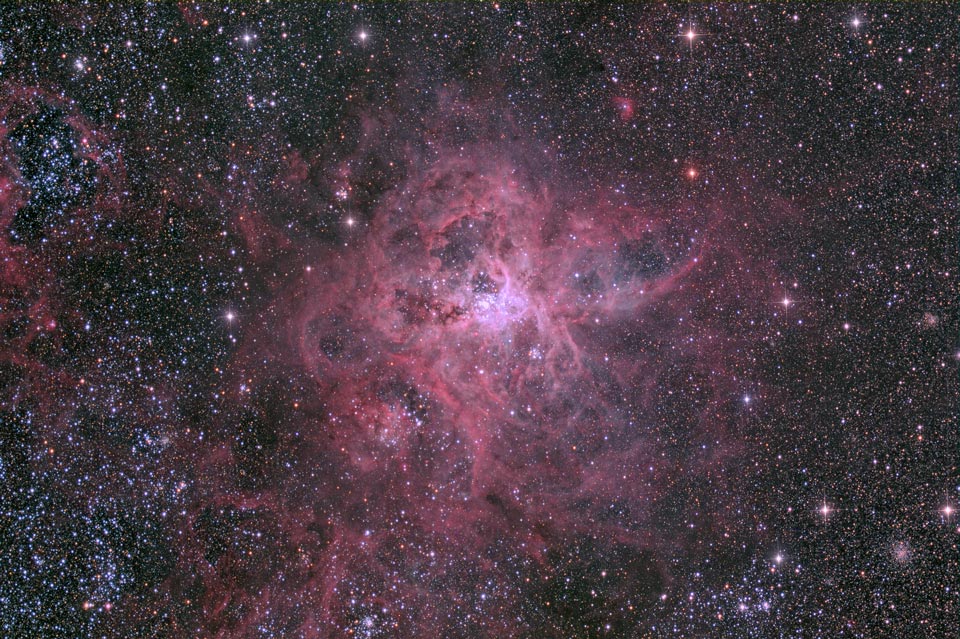 It is the largest and most complex star forming region in the entire galactic neighborhood. Located in the Large Magellanic Cloud, a small satellite galaxy orbiting our Milky Way galaxy, the region's spidery appearance is responsible for its popular name, the Tarantula nebula. This tarantula, however, is about 1,000 light-years across. Were it placed at the distance of Milky Way's Orion Nebula, only 1,500 light-years distant and the nearest stellar nursery to Earth, it would appear to cover about 30 degrees (60 full moons) on the sky. Intriguing details of the nebula are visible in the above image shown in near true colors. The spindly arms of the Tarantula nebula surround NGC 2070, a star cluster that contains some of the brightest, most massive stars known, visible in blue on the right. Since massive stars live fast and die young, it is not so surprising that the cosmic Tarantula also lies near the site of a close recent supernova.
__________________
1st in Kommisar's 2009 SM Tournament 1st in I Love You`s 2009 New Year`s Tournament 3rd in EnR's Mashfest '08 tournament 5th in Phynx's Unofficial FFR Tournament 9th in D3 of the 2008-2009 4th Official FFR Tournament 10th in D5 of the 2010 5th Official FFR Tournament 10th in D6 of the 2011-2012 6th Official FFR Tournament FMO AAA Count: 71 FGO AAA Count: 10 Bluearrowll = The Canadian player who can not detect awkward patterns. If it's awkward for most people, it's normal for Terry. If the file is difficult but super straight forward, he has issues. If he's AAAing a FGO but then heard that his favorite Hockey team was losing by a point, Hockey > FFR PS: Cool AAA's Terry - I Love You An Alarm Clock's Haiku beep beep beep beep beep beep beep beep beep beep beep beep beep beep beep beep beep - ieatyourlvllol |
|
|

|
|
|
#843 |
|
⊙▃⊙
|
Daily Suspicious0bserver's Weather Post:
February 18, 2014 What's in the sky tonight? February 18, 2014 -Major news outlets are reporting the close approach of a "huge asteroid" to Earth on February 17-18. 2000 EM26 is about as wide as 2 football fields and it is flying past our planet 2 million miles away at 27,000 mph. It's all true. It's also all hype. This asteroid is little different than half-a-dozen other space rocks that have already whizzed passed Earth at similar distances in February, including one, 2006 DP14, that is almost 4 times larger. The sudden attention to 2000 EM26 is disproportionate to its actual uniqueness or potential impact. -On Feb. 17th at approximately 04:50 UT, a magnetic filament erupted from the sun's western limb. NASA's Solar Dynamics Observatory captured this high-resolution image of the blast. Because of its location on the sun's western limb, the eruption did not send a CME toward Earth. However, there was an effect on our planet: Shortwave radio loudspeakers roared with static, an event called a Type II radio burst. Here's how it works: The explosion sent shock waves rippling through the sun's atmosphere. Those shock waves, in turn, triggered plasma instabilities in the solar corona that emit strong radio emissions. The static-y "roar" of the explosion was picked up by solar observatories and ham radio stations across the dayside of our planet. Based on the sweep of radio frequencies from 20 MHz to 500 MHz, analysts estimate a shock velocity of 776 km/s or 1.7 million mph. That may sound fast, but it is typical for this type of eruption. -By 11 p.m. the waning gibbous Moon is up in the east. Lower left of it shines Spica, and left of Spica, brighter Mars. Very far off to their left, the spring star Arcturus is already climbing the sky. See the scene at left for how the Moon, Mars and Spica are arranged by dawn on Wednesday morning. 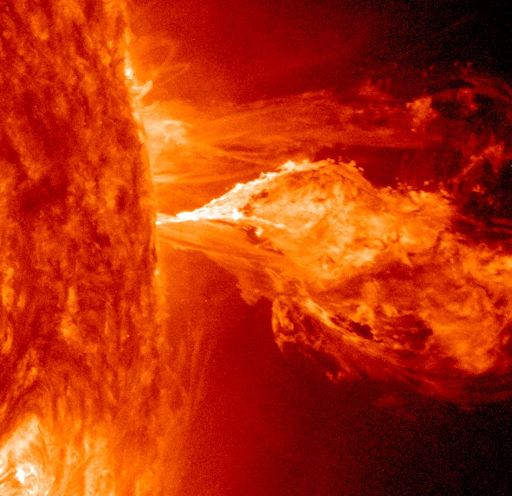  Astro Picture of the Day: February 18, 2014  An important threshold on Mars has now been crossed. Landing in mid-2012, the Curiosity rover is searching for clues of whether life could ever have existed on the red planet. Recent findings of Curiosity include evidence for an ancient (but now dried) freshwater lake, and the non-detection of the biomarker methane in the Martian atmosphere. To continue its investigation, the car-sized rover is on an expedition to roll up Mt. Sharp, the central peak of the large crater in which it landed. Life might have shown preference for water that once ran down the Martian mountain. Two weeks ago, to avoid more dangerous and rocky terrain, Curiosity was directed to roll across a one-meter high sand dune that blocked a useful entrance to Mt. Sharp. Just after the short trip over Dingo Gap was successful, the robotic rover took the above image showing the now-traversed sand mound covered with its wheel tracks.
__________________
1st in Kommisar's 2009 SM Tournament 1st in I Love You`s 2009 New Year`s Tournament 3rd in EnR's Mashfest '08 tournament 5th in Phynx's Unofficial FFR Tournament 9th in D3 of the 2008-2009 4th Official FFR Tournament 10th in D5 of the 2010 5th Official FFR Tournament 10th in D6 of the 2011-2012 6th Official FFR Tournament FMO AAA Count: 71 FGO AAA Count: 10 Bluearrowll = The Canadian player who can not detect awkward patterns. If it's awkward for most people, it's normal for Terry. If the file is difficult but super straight forward, he has issues. If he's AAAing a FGO but then heard that his favorite Hockey team was losing by a point, Hockey > FFR PS: Cool AAA's Terry - I Love You An Alarm Clock's Haiku beep beep beep beep beep beep beep beep beep beep beep beep beep beep beep beep beep - ieatyourlvllol |
|
|

|
|
|
#844 |
|
⊙▃⊙
|
Daily Suspicious0bserver's Weather Post:
February 19, 2014 What's in the sky tonight? February 19, 2014 -Go out after 11 tonight, and low in the east-southeast, where the Moon has just risen or is about to rise, you'll find bright, fiery Mars with Spica to its right. -A minor geomagnetic storm is in progress on Feb. 18-19. The cause: Magnetic fields in the interplanetary medium have tipped south, opening a crack in Earth's defenses against the solar wind. High-latitude sky-watchers should be alert for auroras.  Astro Picture of the Day: February 19, 2014 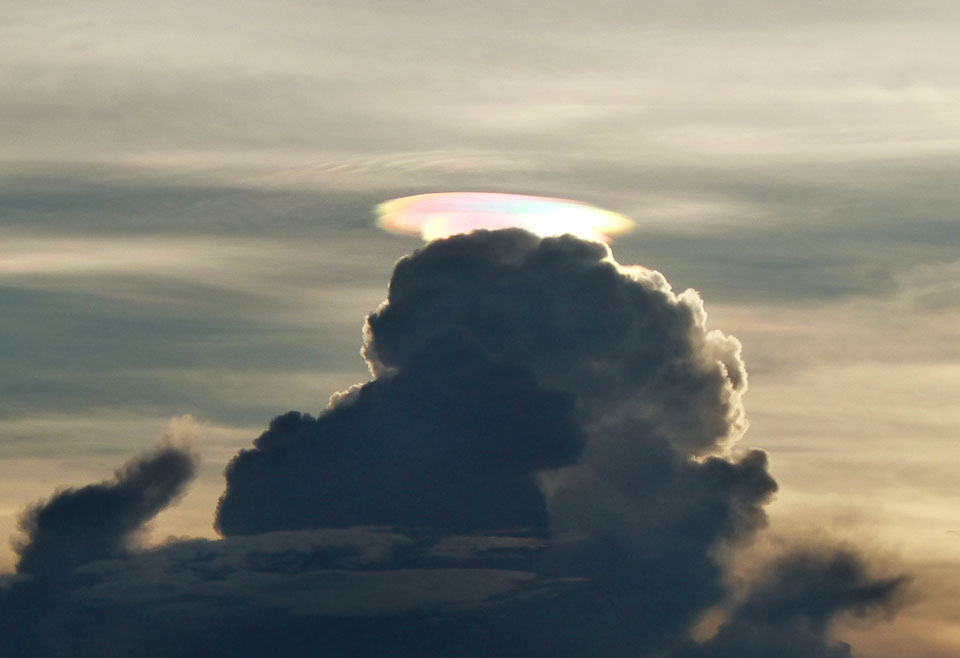 How many dark clouds have a multicolored lining? Pictured, behind this darker cloud, is a pileus iridescent cloud, a group of water droplets that have a uniformly similar size and so together diffract different colors of sunlight by different amounts. The above image was taken just before sunset when it was noticed by chance by a photographer in Murambi East, near Odzi Valley and the Mtanda Range of Zimbabwe. Also captured were unusual cloud ripples above the pileus cloud. The formation of a rare pileus cloud capping a common cumulus cloud is an indication that the lower cloud is expanding upward and might well develop into a storm. In this case, however, only a few minutes after the colorful cloud was noticed, it disappeared.
__________________
1st in Kommisar's 2009 SM Tournament 1st in I Love You`s 2009 New Year`s Tournament 3rd in EnR's Mashfest '08 tournament 5th in Phynx's Unofficial FFR Tournament 9th in D3 of the 2008-2009 4th Official FFR Tournament 10th in D5 of the 2010 5th Official FFR Tournament 10th in D6 of the 2011-2012 6th Official FFR Tournament FMO AAA Count: 71 FGO AAA Count: 10 Bluearrowll = The Canadian player who can not detect awkward patterns. If it's awkward for most people, it's normal for Terry. If the file is difficult but super straight forward, he has issues. If he's AAAing a FGO but then heard that his favorite Hockey team was losing by a point, Hockey > FFR PS: Cool AAA's Terry - I Love You An Alarm Clock's Haiku beep beep beep beep beep beep beep beep beep beep beep beep beep beep beep beep beep - ieatyourlvllol |
|
|

|
|
|
#845 |
|
⊙▃⊙
|
Daily Suspicious0bserver's Weather Post:
February 20, 2014 What's in the sky tonight? February 20, 2014 -A minor geomagnetic storm was already in progress on Feb. 19th when a CME struck Earth's magnetic field at approximately 0200 UT. The impact revved-up the storm and sent Northern Lights spilling across the Canadian border into the United States. Douglas Kiesling sends this picture from Sauk Rapids, Minnesota. "The auroras were so bright, I could actually see a snowy owl on power pole back lit by the green glow," says Kiesling. "The owl itself was illuminated by bright moonlight." High-latitude sky watchers, if it's dark where you live, look for auroras. For the second time in 24 hours, a CME has hit Earth's magnetic field. The impact on Feb. 20th at ~0300 UT re-energized a subsiding geomagnetic storm that sparked bright auroras over North America on Feb. 19th. As Earth's magnetic field reverberates from this second blow, auroras are spreading around the Arctic Circle and possibly down toward lower latitudes. -As dawn breaks Friday morning the 21st, spot the waning Moon in the south with Saturn to its left. Off to their right are Mars and Spica (out of the frame above).  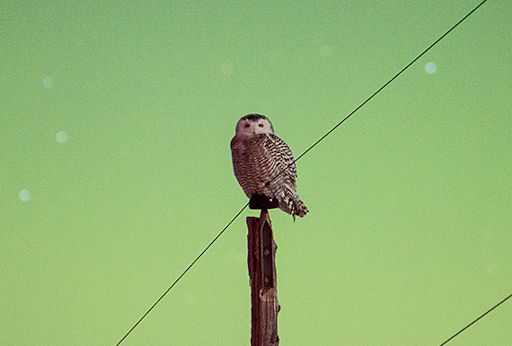 Astro Picture of the Day: February 20, 2014 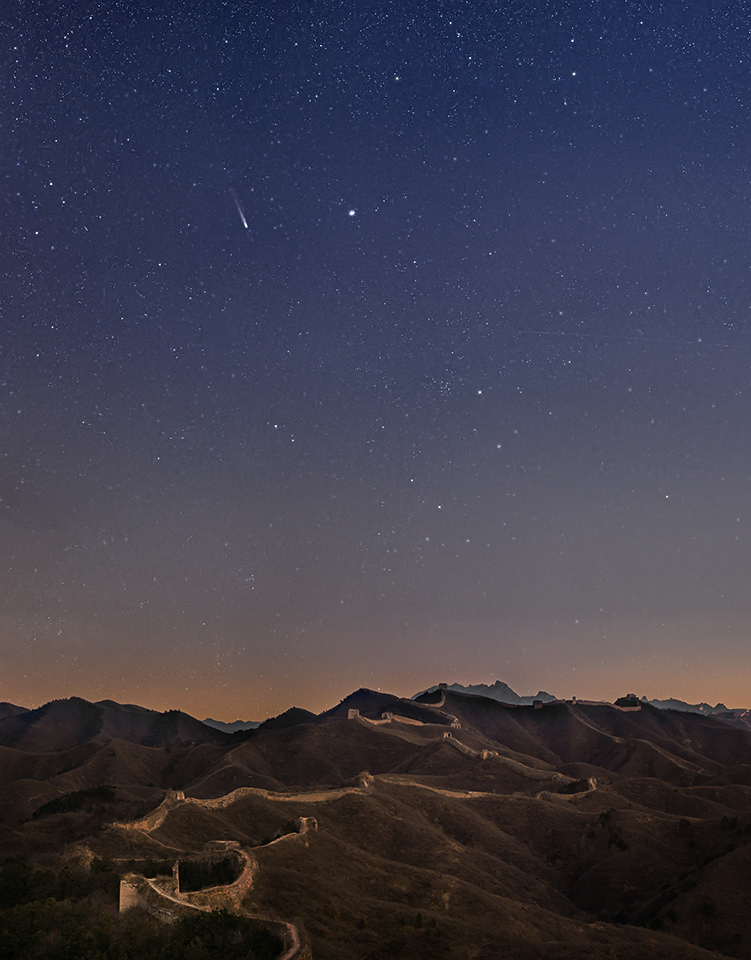 Fading now as it returns to the outer solar system Comet Lovejoy (C/2013 R1) still graces planet Earth's sky, a delicate apparition in binoculars or small telescopes. The comet, a relic of the solar system's formative years, is seen here rising in the morning twilight on January 12 among the stars of Ophiuchus, the Serpent Bearer. Posing near the comet is bright star Alpha Ophiuchi, also known as Rasalhague, from Arabic "the head of the serpent collector". Of course, the serpentine shape below is the ancient Great Wall of China, along the Panlongshan section northeast of Beijing. Panlongshan is translated as "a coiled dragon". A moving and fortuitous scene, it was captured with a digital camera and telephoto lens in two consecutive exposures. The exposures were merged to show a natural looking foreground and twilight sky.
__________________
1st in Kommisar's 2009 SM Tournament 1st in I Love You`s 2009 New Year`s Tournament 3rd in EnR's Mashfest '08 tournament 5th in Phynx's Unofficial FFR Tournament 9th in D3 of the 2008-2009 4th Official FFR Tournament 10th in D5 of the 2010 5th Official FFR Tournament 10th in D6 of the 2011-2012 6th Official FFR Tournament FMO AAA Count: 71 FGO AAA Count: 10 Bluearrowll = The Canadian player who can not detect awkward patterns. If it's awkward for most people, it's normal for Terry. If the file is difficult but super straight forward, he has issues. If he's AAAing a FGO but then heard that his favorite Hockey team was losing by a point, Hockey > FFR PS: Cool AAA's Terry - I Love You An Alarm Clock's Haiku beep beep beep beep beep beep beep beep beep beep beep beep beep beep beep beep beep - ieatyourlvllol |
|
|

|
|
|
#846 |
|
⊙▃⊙
|
Daily Suspicious0bserver's Weather Post:
February 21, 2014 What's in the sky tonight? February 21, 2014 -Capella passes closest to straight overhead (for skywatchers at mid-northern latitudes) around 7 p.m. now, depending on how far east or west you are in your time zone. At the time this happens, Rigel in Orion's leading foot marks due south.  News Posted Today: February 20, 2014 The Purest Star Tells an Ancient Tale  Astro Picture of the Day: February 21, 2014 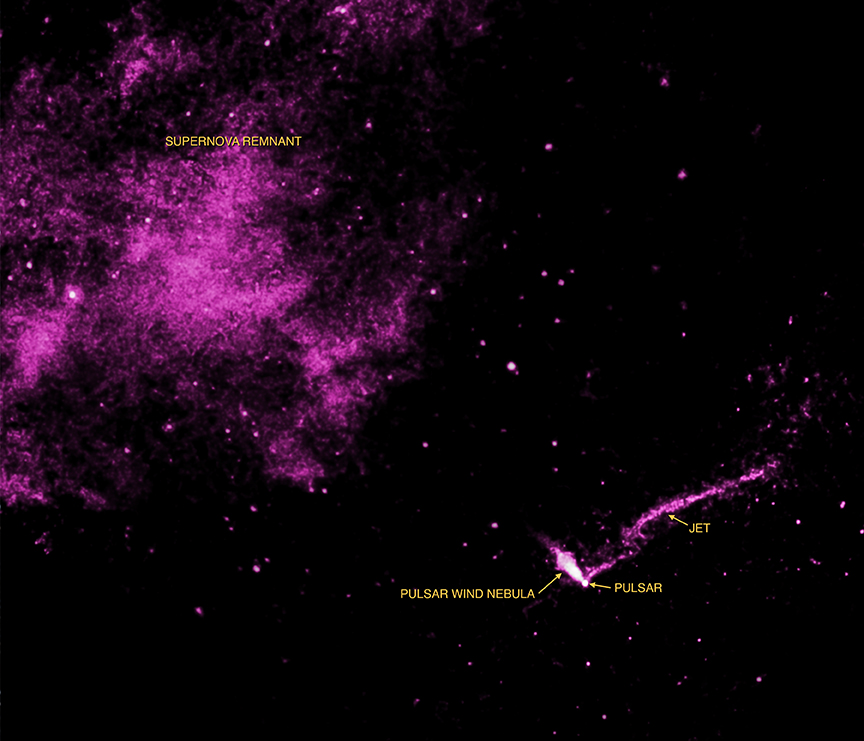 The Lighthouse nebula was formed by the wind of a pulsar, a rapidly rotating, magnetized neutron star, as it speeds through the interstellar medium at over 1,000 kilometers per second. Some 23,000 light-years distant toward the southern constellation Carina, pulsar and wind nebula (cataloged as IGR J1104-6103) are indicated at the lower right in this remarkable image from the Chandra X-ray Observatory. Energetic particles generated by the pulsar are swept back into the wind's comet-like tail trailing up and to the left, along the direction of the pulsar's motion away from its parent supernova remnant. Both runaway pulsar and expanding remnant debris field are the aftermath of the core-collapse-explosion of a massive star, with the pulsar kicked out by the supernova explosion. Adding to the scene of exotic cosmic extremes is a long, spiraling jet extending for almost 37 light-years, but nearly at a right angle to the pulsar's motion. The high-energy particle jet is the longest known for any object in our Milky Way galaxy.
__________________
1st in Kommisar's 2009 SM Tournament 1st in I Love You`s 2009 New Year`s Tournament 3rd in EnR's Mashfest '08 tournament 5th in Phynx's Unofficial FFR Tournament 9th in D3 of the 2008-2009 4th Official FFR Tournament 10th in D5 of the 2010 5th Official FFR Tournament 10th in D6 of the 2011-2012 6th Official FFR Tournament FMO AAA Count: 71 FGO AAA Count: 10 Bluearrowll = The Canadian player who can not detect awkward patterns. If it's awkward for most people, it's normal for Terry. If the file is difficult but super straight forward, he has issues. If he's AAAing a FGO but then heard that his favorite Hockey team was losing by a point, Hockey > FFR PS: Cool AAA's Terry - I Love You An Alarm Clock's Haiku beep beep beep beep beep beep beep beep beep beep beep beep beep beep beep beep beep - ieatyourlvllol |
|
|

|
|
|
#847 |
|
⊙▃⊙
|
Daily Suspicious0bserver's Weather Post:
February 22, 2014 What's in the sky tonight? February 22, 2014 -This year's big, bright "Winter Diamond" — Jupiter at the top, Sirius at the bottom, and Procyon and Betelgeuse forming the two side corners — stands upright in the south around 8 or 9 p.m. now. -NOAA forecasters estimate a 50% chance of geomagnetic storms this weekend in response to CMEs due to arrive on Saturday and Sunday. Both CMEs are minor, but the 1-2 punch could cause significant magnetic disturbances around the poles. High-latitude sky watchers should remain alert for auroras. -One month ago, sunspot AR1967 emerged over the sun's eastern limb and unleashed almost two dozen M-class solar flares as it crossed the solar disk. Is it about to happen again? This weekend, the long-lived sunspot is due to return from the farside of the sun. A farside CME that billowed over the eastern limb on Feb. 21st suggests that AR1967 is still active. -If AR1967 reappears as expected it will mark the third time the active region has crossed the face of the sun. The first time was in December 2013 when it was called AR1944. Sunspots rarely last more than a few weeks; a few months is remarkable. By now the returning spot is probably a decayed shell of its former self, although the CME hints at some remaining potency.  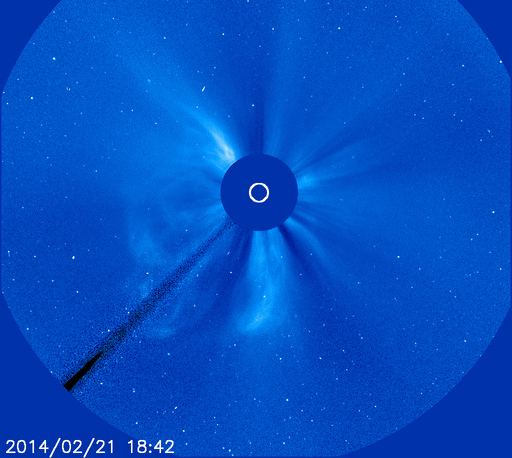 Astro Picture of the Day: February 22, 2014 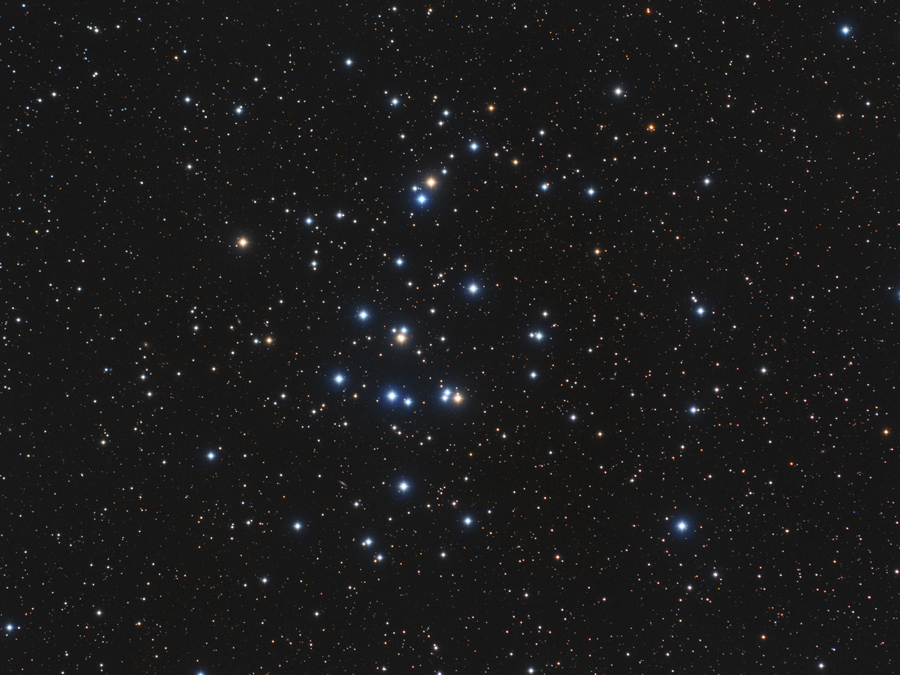 A mere 600 light-years away, M44 is one of the closest star clusters to our solar system. Also known as the Praesepe or the Beehive cluster its stars are young though, about 600 million years old compared to our Sun's 4.5 billion years. Based on similar ages and motion through space, M44 and the even closer Hyades star cluster in Taurus are thought to have been born together in the same large molecular cloud. An open cluster spanning some 15 light-years, M44 holds 1,000 stars or so and covers about 3 full moons (1.5 degrees) on the sky in the constellation Cancer. Visible to the unaided eye, M44 has been recognized since antiquity. Described as a faint cloud or celestial mist long before being included as the 44th entry in Charles Messier's 18th century catalog, the cluster was not resolved into its individual stars until telescopes were available. A popular target for modern, binocular-equiped sky gazers, the cluster's few yellowish tinted, cool, red giants are scattered through the field of its brighter hot blue main sequence stars in this colorful stellar group snapshot.
__________________
1st in Kommisar's 2009 SM Tournament 1st in I Love You`s 2009 New Year`s Tournament 3rd in EnR's Mashfest '08 tournament 5th in Phynx's Unofficial FFR Tournament 9th in D3 of the 2008-2009 4th Official FFR Tournament 10th in D5 of the 2010 5th Official FFR Tournament 10th in D6 of the 2011-2012 6th Official FFR Tournament FMO AAA Count: 71 FGO AAA Count: 10 Bluearrowll = The Canadian player who can not detect awkward patterns. If it's awkward for most people, it's normal for Terry. If the file is difficult but super straight forward, he has issues. If he's AAAing a FGO but then heard that his favorite Hockey team was losing by a point, Hockey > FFR PS: Cool AAA's Terry - I Love You An Alarm Clock's Haiku beep beep beep beep beep beep beep beep beep beep beep beep beep beep beep beep beep - ieatyourlvllol |
|
|

|
|
|
#848 |
|
⊙▃⊙
|
Congratulations Team Canada on the gold medal this morning ##
Daily Suspicious0bserver's Weather Post: February 23, 2014 What's in the sky tonight? February 23, 2014 -The asteroid 2 Pallas, barely past opposition, is a few degrees southeast of Alphard in Hydra. It remains at magnitude 7.0 all week as it creeps northward, visible in binoculars and small telescopes. -NOAA forecasters estimate a 50% chance of minor geomagnetic storms on Sunday, Feb. 23rd, in response to glancing blows from one or two incoming CMEs. Arctic sky watchers should remain alert for auroras. -On the night of Feb. 20/21, photographer Dennis Mammana was stationed on Pedro Dome near Fairbanks, Alaska, in hopes of recording the Northern Lights. "I caught this instead—a tiny and bright cloud that rose from the western sky and spread slightly and faded over an hour or so," says Mammana. Here is a composite of two of his shots. The cloud resembles a rocket fuel dump. Scientists from the University of Alaska frequently launch rockets from the nearby Poker Flat Research Range to study auroras. But on this night there were no rocket launches on Poker Flat. There was, however, a launch thousands of miles away. A Delta 4 rocket blasted off from Cape Canaveral carrying a GPS satellite. Veteran satellite watcher Marco Langbroek says this is it: "The mystery object on the Mammana photo from Pedro Dome near Fairbanks, Alaska, is a fuel vent from the Feb 20 launch of GPS 2F-05 (USA 248, 20114-008A, #39533). Although the satellite is in an orbit with a 54.98 degree inclination, that does not mean it was not visible from Mammana's location at 65N," he continues. "It is in a very high orbit and was at an altitude of over 20,000 km at that moment. At such an altitude it is visible from 65 N, low in the west in this case." The attached sky map prepared by Langbroek shows the position of the satellite (labeled "Object A") in the sky above Alaska at the time Mammana photographed the cloud. The sky map and the photo are a good match.  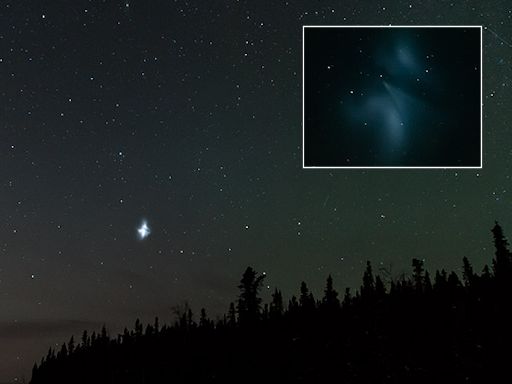 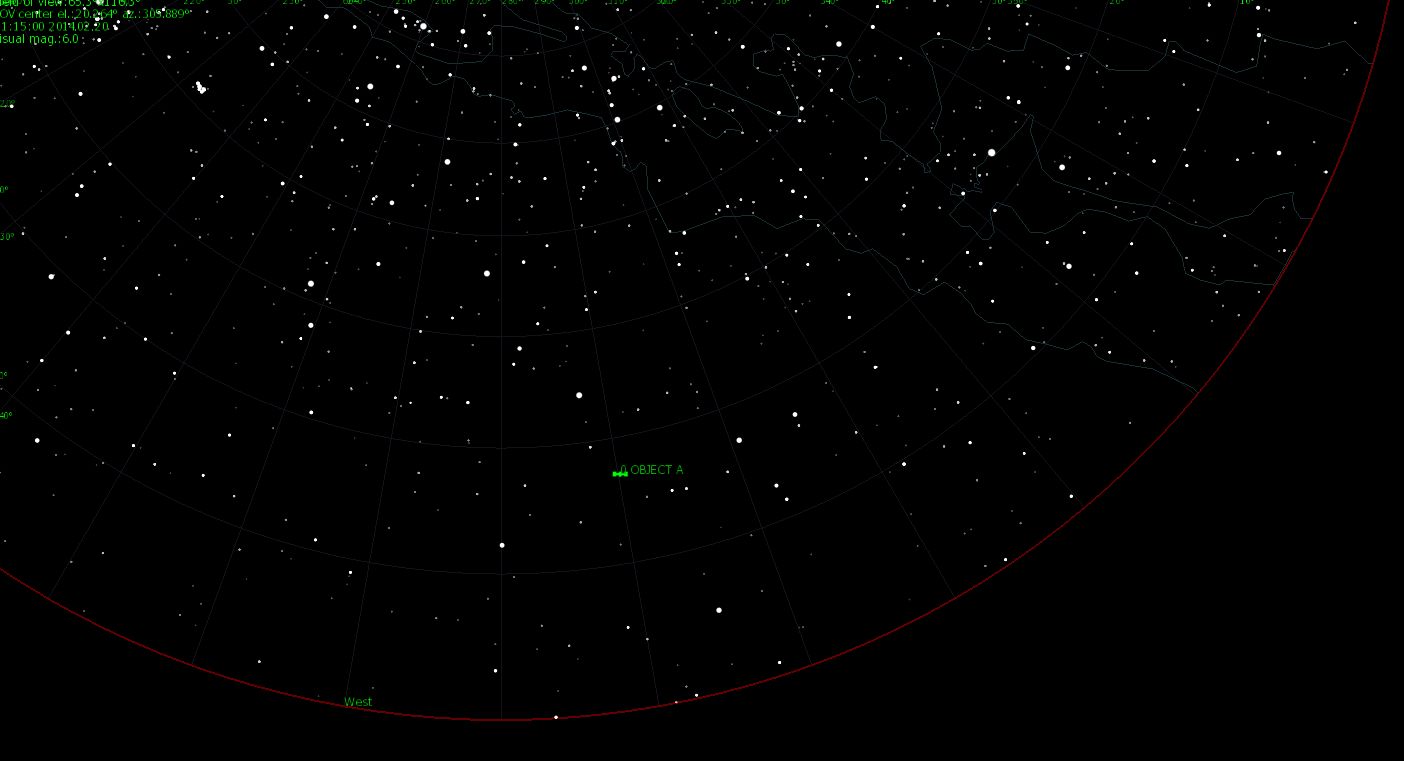 News Posted Today: February 21, 2014 Mapping a Supernova's Radioactive Glow  Astro Picture of the Day: February 23, 2014  If this is Saturn, where are the rings? When Saturn's "appendages" disappeared in 1612, Galileo did not understand why. Later that century, it became understood that Saturn's unusual protrusions were rings and that when the Earth crosses the ring plane, the edge-on rings will appear to disappear. This is because Saturn's rings are confined to a plane many times thinner, in proportion, than a razor blade. In modern times, the robot Cassini spacecraft orbiting Saturn now also crosses Saturn's ring plane. A series of plane crossing images from 2005 February was dug out of the vast online Cassini raw image archive by interested Spanish amateur Fernando Garcia Navarro. Pictured above, digitally cropped and set in representative colors, is the striking result. Saturn's thin ring plane appears in blue, bands and clouds in Saturn's upper atmosphere appear in gold. Details of Saturn's rings can be seen in the high dark shadows across the top of this image, taken back in 2005. Moons appear as bumps in the rings.
__________________
1st in Kommisar's 2009 SM Tournament 1st in I Love You`s 2009 New Year`s Tournament 3rd in EnR's Mashfest '08 tournament 5th in Phynx's Unofficial FFR Tournament 9th in D3 of the 2008-2009 4th Official FFR Tournament 10th in D5 of the 2010 5th Official FFR Tournament 10th in D6 of the 2011-2012 6th Official FFR Tournament FMO AAA Count: 71 FGO AAA Count: 10 Bluearrowll = The Canadian player who can not detect awkward patterns. If it's awkward for most people, it's normal for Terry. If the file is difficult but super straight forward, he has issues. If he's AAAing a FGO but then heard that his favorite Hockey team was losing by a point, Hockey > FFR PS: Cool AAA's Terry - I Love You An Alarm Clock's Haiku beep beep beep beep beep beep beep beep beep beep beep beep beep beep beep beep beep - ieatyourlvllol |
|
|

|
|
|
#849 |
|
⊙▃⊙
|
Daily Suspicious0bserver's Weather Post:
February 24, 2014 What's in the sky tonight? February 24, 2014 -During dawn on Tuesday the 25th, the waning crescent Moon shines upper right of Venus in the southeast. -The solar wind blowing around Earth is gusty and unsettled--probably a side-effect of one or more minor CMEs that swept past our planet over the weekend. This is sparking intermittent auroras around the poles, but no widespread geomagnetic storms. The forecast for the next 24-48 hours calls for growing calm. -Although the Earth-facing side of the sun is peppered with spots, that's not where the action is. For the past few days, most solar activity has been coming from a location hidden behind the sun's southeastern limb. It is likely old sunspot AR1967, set to return from a two-week transit around the farside of the sun. The place to watch is circled. If AR1967 does come back, it will mark the third time the active region has crossed the visible face of the sun. The first time was in early January when it was called "AR1944." Sunspots seldom last more than two or three weeks; two or three months is remarkable. By now the returning spot is probably a decayed shell of its former self, although flares and CMEs flying over the southeastern limb hint at some remaining potency.  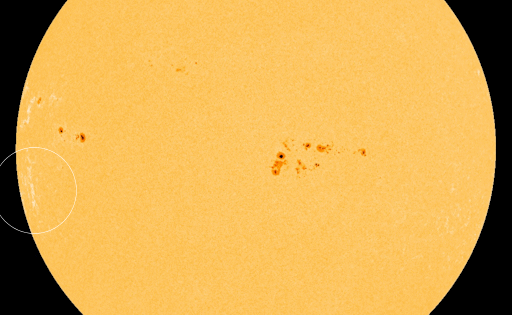 Astro Picture of the Day: February 24, 2014  One of the Expedition 38 crew members aboard the International Space Station downlinked this vertical 600mm night view of Sochi, Russia, which clearly shows the site of the 2014 Winter Olympics while they are just a few days under way. Fisht Stadium where the Opening Ceremonies were held on Feb. 7 is easily recognizable as the bright circular structure. Sochi is a city in Krasnodar Krai, Russia, located on the Black Sea coast near the border between Georgia/Abkhazia and Russia. It has an area of 1,353 square miles or 3,505 square kilometers. Hockey fans aboard the International Space Station could glance at the roof of the Bolshoy Ice Arena just to the south west of Fisht Stadium in this image and see the score of the two teams playing hockey at that particular moment.
__________________
1st in Kommisar's 2009 SM Tournament 1st in I Love You`s 2009 New Year`s Tournament 3rd in EnR's Mashfest '08 tournament 5th in Phynx's Unofficial FFR Tournament 9th in D3 of the 2008-2009 4th Official FFR Tournament 10th in D5 of the 2010 5th Official FFR Tournament 10th in D6 of the 2011-2012 6th Official FFR Tournament FMO AAA Count: 71 FGO AAA Count: 10 Bluearrowll = The Canadian player who can not detect awkward patterns. If it's awkward for most people, it's normal for Terry. If the file is difficult but super straight forward, he has issues. If he's AAAing a FGO but then heard that his favorite Hockey team was losing by a point, Hockey > FFR PS: Cool AAA's Terry - I Love You An Alarm Clock's Haiku beep beep beep beep beep beep beep beep beep beep beep beep beep beep beep beep beep - ieatyourlvllol |
|
|

|
|
|
#850 |
|
⊙▃⊙
|
Daily Suspicious0bserver's Weather Post:
February 25, 2014 What's in the sky tonight? February 25, 2014 -During dawn on Wednesday the 26th, Venus shines upper right of the waning Moon low in the southeast, as shown here. At the time of dawn in the Americas they appear closer together than they did on Tuesday morning. Several hours earlier, the Moon passes right across — occults — Venus for central and western Africa, India, and parts of China and Southeast Asia (at roughly 5h Universal Time February 26th). Table is found here: http://www.lunar-occultations.com/io.../0226venus.htm -Returning sunspot AR1967 unleashed a powerful X4.9-class solar flare on Feb. 25th at 00:49 UTC. This is the most intense flare of 2014 so far, and one of the most intense of the current solar cycle. NASA's Solar Dynamics Observatory recorded the extreme ultraviolet flash. Although this flare is impressive, its effects are mitigated by the location of the blast site -near the sun's southeastern limb, and not facing Earth. Indeed, a bright coronal mass ejection (CME) which raced away from the sun shortly after the flare appears set to miss our planet: Radio emissions from shock waves at the leading edge of the CME suggest an expansion velocity near 2000 km/s or 4.4 million mph. If such a fast-moving cloud did strike Earth, the resulting geomagnetic storms could be severe. However, because its trajectory is so far off the sun-Earth line, the CME will deliver a glancing blow, at best, and probably no blow at all. The source of the eruption is long-lived sunspot AR1967, now beginning its third trip across the Earthside of the sun. This region was an active producer of flares during its previous transits, and it looks like the third time will be little different. By tradition, sunspots are renumbered each time they return, so AR1967 will be designated AR1990.  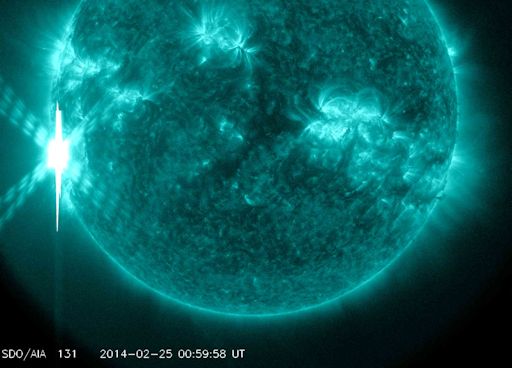 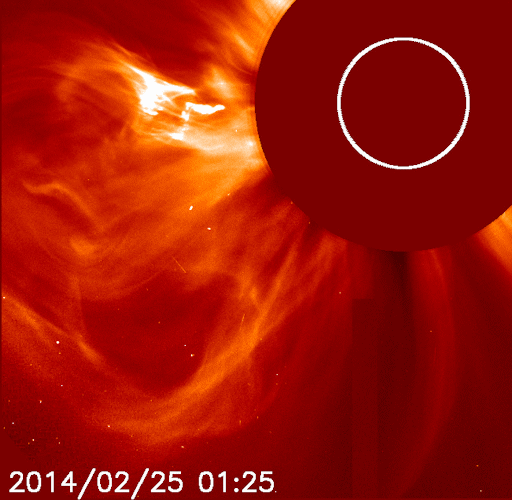 Astro Picture of the Day: February 25, 2014 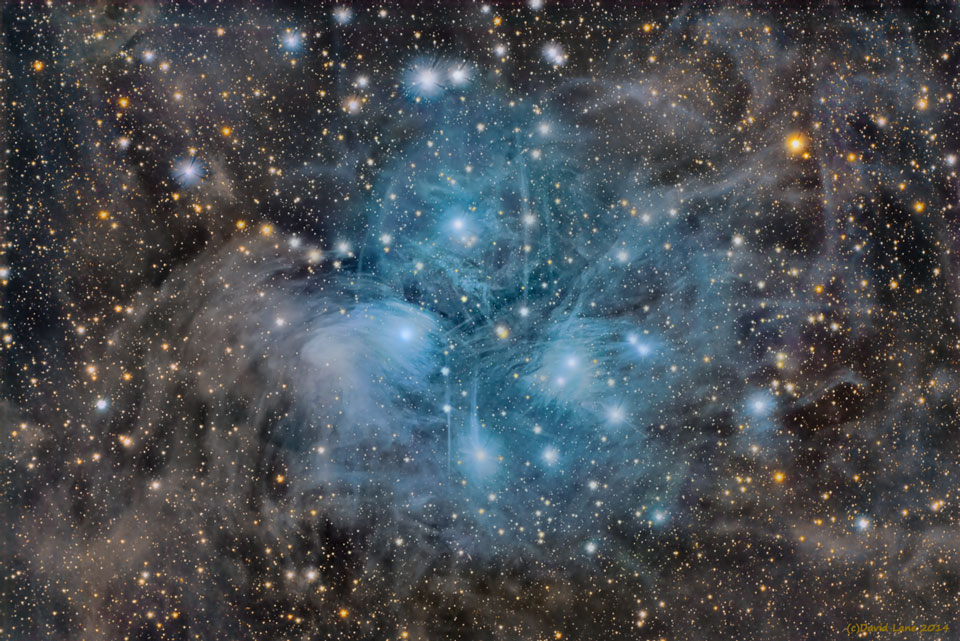 The well known Pleiades star cluster is slowly destroying part of a passing cloud of gas and dust. The Pleiades is the brightest open cluster of stars on Earth's sky and can be seen from almost any northerly location with the unaided eye. The passing young dust cloud is thought to be part of Gould's belt, an unusual ring of young star formation surrounding the Sun in the local Milky Way Galaxy. Over the past 100,000 years, part Gould's belt is by chance moving right through the older Pleiades and is causing a strong reaction between stars and dust. Pressure from the star's light significantly repels the dust in the surrounding blue reflection nebula, with smaller dust particles being repelled more strongly. A short-term result is that parts of the dust cloud have become filamentary and stratified, as seen in the above deep-exposure image.
__________________
1st in Kommisar's 2009 SM Tournament 1st in I Love You`s 2009 New Year`s Tournament 3rd in EnR's Mashfest '08 tournament 5th in Phynx's Unofficial FFR Tournament 9th in D3 of the 2008-2009 4th Official FFR Tournament 10th in D5 of the 2010 5th Official FFR Tournament 10th in D6 of the 2011-2012 6th Official FFR Tournament FMO AAA Count: 71 FGO AAA Count: 10 Bluearrowll = The Canadian player who can not detect awkward patterns. If it's awkward for most people, it's normal for Terry. If the file is difficult but super straight forward, he has issues. If he's AAAing a FGO but then heard that his favorite Hockey team was losing by a point, Hockey > FFR PS: Cool AAA's Terry - I Love You An Alarm Clock's Haiku beep beep beep beep beep beep beep beep beep beep beep beep beep beep beep beep beep - ieatyourlvllol |
|
|

|
|
|
#851 |
|
⊙▃⊙
|
Daily Suspicious0bserver's Weather Post:
February 26, 2014 What's in the sky tonight? February 26, 2014 -Set your alarm for dawn. Venus and the crescent Moon are having a beautiful pre-sunrise conjunction on Wednesday, Feb. 26th. Look east! It's a great way to start the day. [more] In a broad path stretching from central Africa across the Indian Ocean to China, the conjunction was so tight that the Moon actually eclipsed Venus. Ravindra Aradhya sends this picture from Bangalore, India, taken moments before Venus disappeared behind the lunar limb." A crescent moon occulting a crescent Venus in broad daylight was an amazing sight," says Aradhya. -About 30 minutes before sunrise Thursday morning, scan with binoculars very low in the east-southeast (far lower left of Venus) for the superthin crescent Moon with Mercury to its lower left, as shown here (as seen from North America).  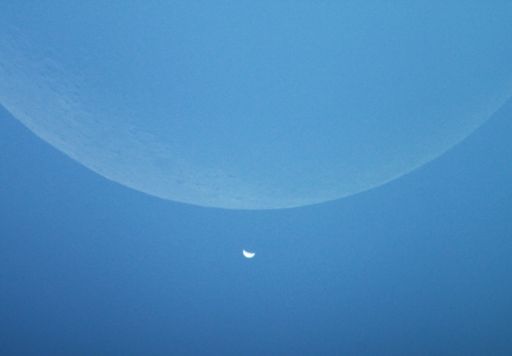 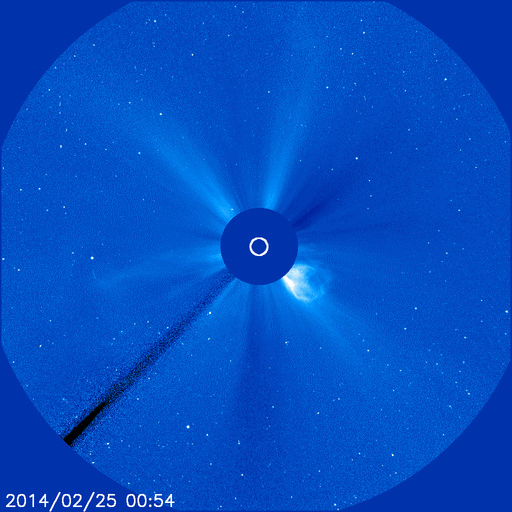 Astro Picture of the Day: February 26, 2014 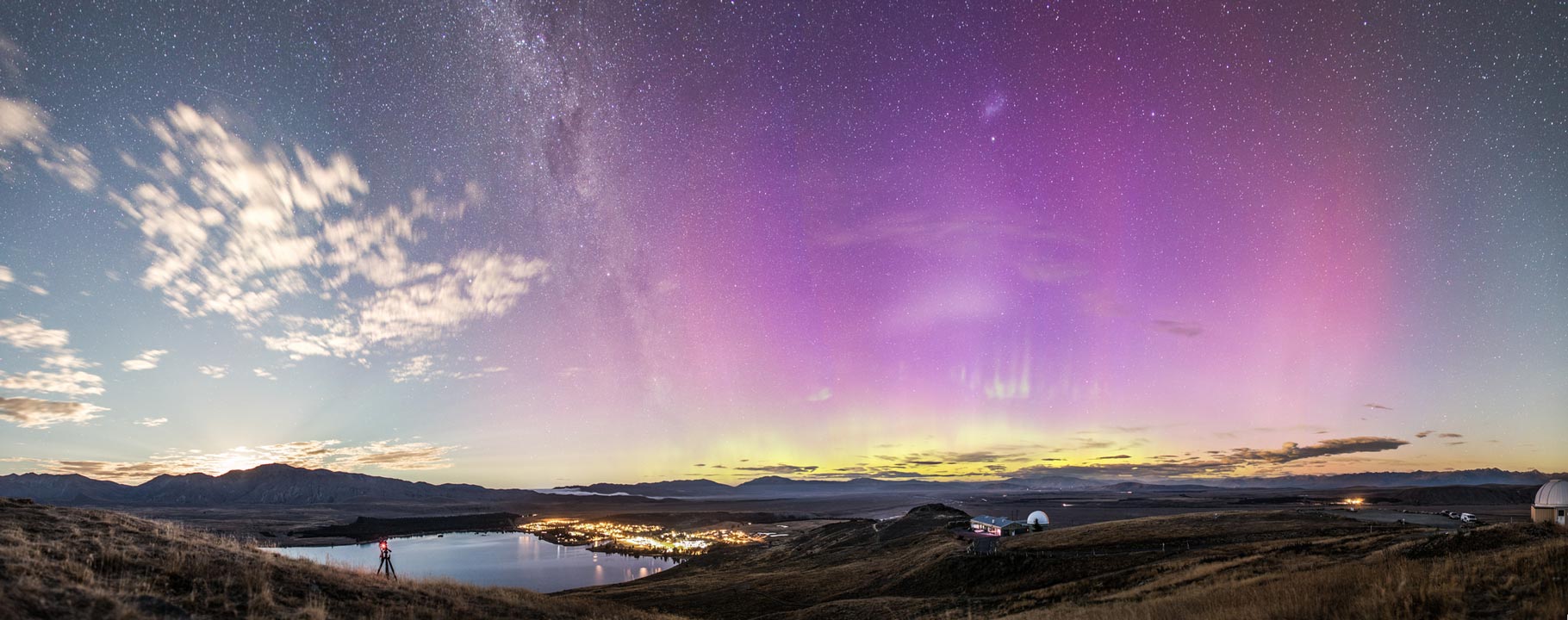 Sometimes the more you look at an image, the more you see. Such may be the case for this beautiful nighttime panorama taken last week in New Zealand. Visible right off, on the far left, are common clouds, slightly altered by the digital fusion of combining 11 separate 20-second exposures. More striking, perhaps, is the broad pink aurora that dominates the right part of the image, a less common auroral color that is likely tinted by excited oxygen atoms high in Earth's atmosphere. Keep looking and you might notice a bright light just beyond the mountain on the left. That is the rising Moon -- and an even closer look will reveal faint crepuscular rays emanating from it. Musing over the image center may cause you to notice the central band of the Milky Way Galaxy which here appears to divide, almost vertically, the left clouds from the right aurora. Inspecting the upper right of the image reveals a fuzzy patch, high in the sky, that is the Small Magellanic Cloud. Numerous stars discretely populate the distant background. Back on Earth, the image foreground features two domes of the Mt. John University Observatory and a camera tripod looking to capture much of this scene over a serene Lake Tekapo.
__________________
1st in Kommisar's 2009 SM Tournament 1st in I Love You`s 2009 New Year`s Tournament 3rd in EnR's Mashfest '08 tournament 5th in Phynx's Unofficial FFR Tournament 9th in D3 of the 2008-2009 4th Official FFR Tournament 10th in D5 of the 2010 5th Official FFR Tournament 10th in D6 of the 2011-2012 6th Official FFR Tournament FMO AAA Count: 71 FGO AAA Count: 10 Bluearrowll = The Canadian player who can not detect awkward patterns. If it's awkward for most people, it's normal for Terry. If the file is difficult but super straight forward, he has issues. If he's AAAing a FGO but then heard that his favorite Hockey team was losing by a point, Hockey > FFR PS: Cool AAA's Terry - I Love You An Alarm Clock's Haiku beep beep beep beep beep beep beep beep beep beep beep beep beep beep beep beep beep - ieatyourlvllol |
|
|

|
|
|
#852 |
|
⊙▃⊙
|
Daily Suspicious0bserver's Weather Post:
February 27, 2014 What's in the sky tonight? February 27, 2014 -Sirius shines at its highest in the south by 8 or 9 p.m. Use binoculars to look for the dim open star cluster M41 straight below it by 4°. That's a little less than the width of a typical binocular's field of view. -NOAA forecasters estimate a 45% chance of minor geomagnetic storms on Feb. 27th when a CME from Tuesday's X4-flare is expected to deliver a glancing blow to Earth's magnetic field. A dark and moonless midnight sky favors the visibility of high-latitude auroras. -Yesterday, NASA announced a breakthrough addition to the catalog of new planets. Researchers using Kepler have confirmed 715 new worlds, almost quadrupling the number of planets previously confirmed by the planet-hunting spacecraft. Some of the planets are similar in size to Earth and orbit in the habitable zone of their parent stars. Astro Picture of the Day: February 27, 2014 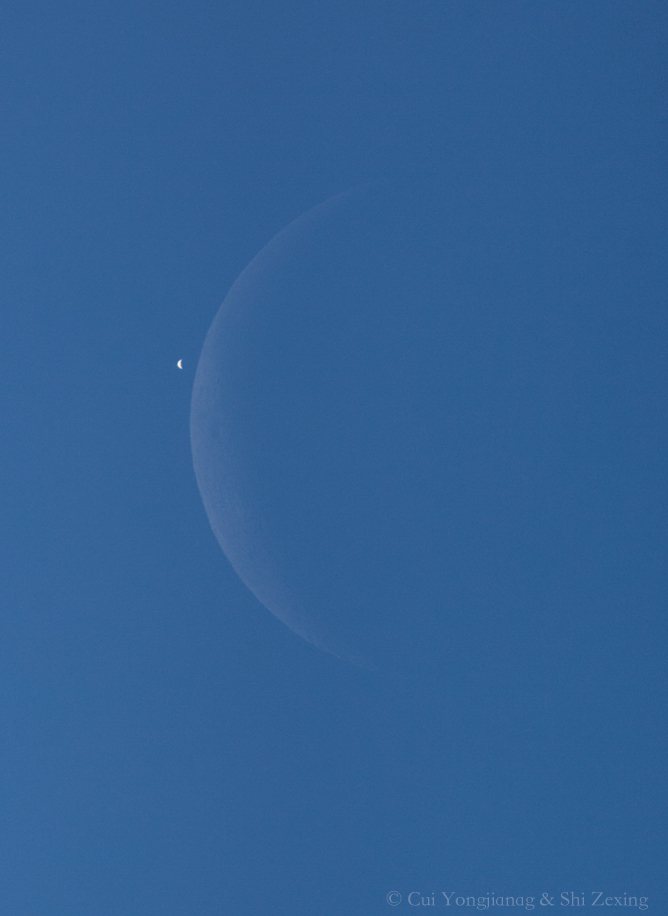 Venus now appears as planet Earth's brilliant morning star standing above the eastern horizon before dawn. For most, the silvery celestial beacon rose in a close pairing with an old crescent Moon on February 26. But seen from locations in western Africa before sunrise, the lunar crescent actually occulted or passed in front of Venus, also in a crescent phase. Farther to the east, the occultation occurred during daylight hours. In fact, this telescopic snapshot of the dueling crescents was captured just before the occultation began under an afternoon's crystal clear skies from Yunnan Province, China. The unforgettable scene was easily visible to the naked eye in broad daylight.
__________________
1st in Kommisar's 2009 SM Tournament 1st in I Love You`s 2009 New Year`s Tournament 3rd in EnR's Mashfest '08 tournament 5th in Phynx's Unofficial FFR Tournament 9th in D3 of the 2008-2009 4th Official FFR Tournament 10th in D5 of the 2010 5th Official FFR Tournament 10th in D6 of the 2011-2012 6th Official FFR Tournament FMO AAA Count: 71 FGO AAA Count: 10 Bluearrowll = The Canadian player who can not detect awkward patterns. If it's awkward for most people, it's normal for Terry. If the file is difficult but super straight forward, he has issues. If he's AAAing a FGO but then heard that his favorite Hockey team was losing by a point, Hockey > FFR PS: Cool AAA's Terry - I Love You An Alarm Clock's Haiku beep beep beep beep beep beep beep beep beep beep beep beep beep beep beep beep beep - ieatyourlvllol |
|
|

|
|
|
#853 |
|
⊙▃⊙
|
Daily Suspicious0bserver's Weather Post:
February 28, 2014 What's in the sky tonight? February 28, 2014 -Have you ever seen Canopus, the second-brightest star after Sirius? In one of the many interesting coincidences that devoted skywatchers know about, Canopus lies almost due south of Sirius: by 36°. That's far enough south that it never appears above your horizon unless you're below latitude 37° N (southern Virginia, southern Missouri, central California). And there you'll need a flat south horizon. Canopus crosses the south point on the horizon just 21 minutes before Sirius does. When to look? Canopus is due south when Beta Canis Majoris — Mirzim, the star a few finger-widths to the right of Sirius — is at its highest point due south. Look straight down from Mirzim then! -Jupiter's moon Io crosses in front of Jupiter's face from 5:56 to 8:11 p.m. Eastern Standard Time this evening. Its tiny black shadow follows behind from 7:02 to 9:17 p.m. EST. Jupiter's Great Red Spot transits the planet's central meridian around 9:09 p.m. EST. -A geomagnetic storm that started on Feb. 27th when a CME sideswiped Earth's magnetic field is subsiding. At its peak, the storm measured G2 on NOAA storm scales and sparked bright auroras over northern Europe, Greenland and Iceland. Tryggvi Már Gunnarsson was driving out of Reykjavik when he saw the display. "As I was driving from Reykjavik to north Iceland I saw this red halo on the sky. My first thought was: A volcano must be erupting!," says Gunnarsson. "Then, as the green colors appeared, I realized this was the aurora borealis. It was one of the most magnificent aurorashows I have ever seen." -If the magnetic storm had lasted just a little longer, bright lights would have appeared over some northern-tier US states, too. Instead, the display was rapidly fading by the time night fell over North America. High-latitude sky watchers should remain alert for auroras as Earth moves through the wake of the CME. NOAA forecasters estimate a 55% chance of resurgent storms on Feb. 28th. 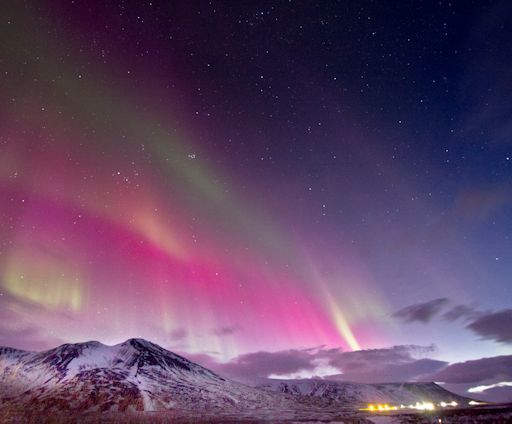 Astro Picture of the Day: February 28, 2014  Only two days past full, February's moon shines through thin clouds, rising on the left in this fisheye night skyscape. The moonlight illuminates a weathered, rounded foreground in the Alabama Hills, conveniently located east of Mt. Whitney along the Sierra Nevada range in California, USA, planet Earth. Orion the Hunter stands at the right, a familiar northern winter constellation. Bright Jupiter, the solar system's ruling gas giant, is near center at the top of the frame. Below Jupiter, Sirius, alpha star of the Big Dog, poses above a bowed and twisted landform known as Möbius Arch, its curve reminiscent of the mathematically famous surface with only one side. Of course, instead of using rock, wind, and weather, a Möbius strip is easier to make with paper, scissors, and tape.
__________________
1st in Kommisar's 2009 SM Tournament 1st in I Love You`s 2009 New Year`s Tournament 3rd in EnR's Mashfest '08 tournament 5th in Phynx's Unofficial FFR Tournament 9th in D3 of the 2008-2009 4th Official FFR Tournament 10th in D5 of the 2010 5th Official FFR Tournament 10th in D6 of the 2011-2012 6th Official FFR Tournament FMO AAA Count: 71 FGO AAA Count: 10 Bluearrowll = The Canadian player who can not detect awkward patterns. If it's awkward for most people, it's normal for Terry. If the file is difficult but super straight forward, he has issues. If he's AAAing a FGO but then heard that his favorite Hockey team was losing by a point, Hockey > FFR PS: Cool AAA's Terry - I Love You An Alarm Clock's Haiku beep beep beep beep beep beep beep beep beep beep beep beep beep beep beep beep beep - ieatyourlvllol |
|
|

|
|
|
#854 |
|
⊙▃⊙
|
Daily Suspicious0bserver's Weather Post:
March 1, 2014 What's in the sky tonight? March 1, 2014 -Look east after dusk this week for the constellation Leo already climbing up the sky. Its brightest star is Regulus, and the Sickle of Leo extends upper left from there. As the saying goes, Leo announces spring. -Twice every year, around the time of the equinoxes, Earth can pass directly between the Sun and NASA's Solar Dynamics Observatory (SDO), producing a series of beautiful eclipses. SDO's vernal eclipse season began yesterday, producing a near-total blackout of the sun: -For the next three weeks these eclipses will repeat once a day around 07:30 UT. At the beginning of the season, the eclipses are short, only a few minutes long. Their duration increases to 72 minutes, mid-season, before tapering off to minutes again as the season winds down. Because most eclipses are relatively short, there is still plenty of uninterrupted time for SDO to monitor activity on the sun. Researchers estimate a scant 2% data loss averaged over the weeks ahead. 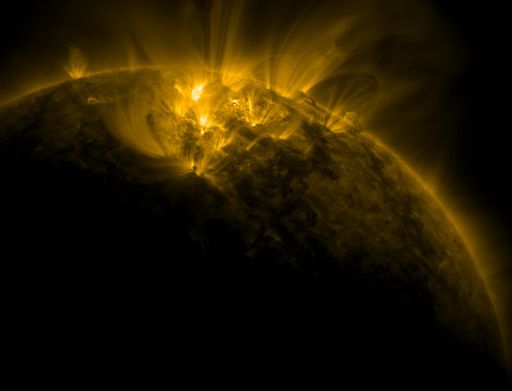 Astro Picture of the Day: March 1, 2014 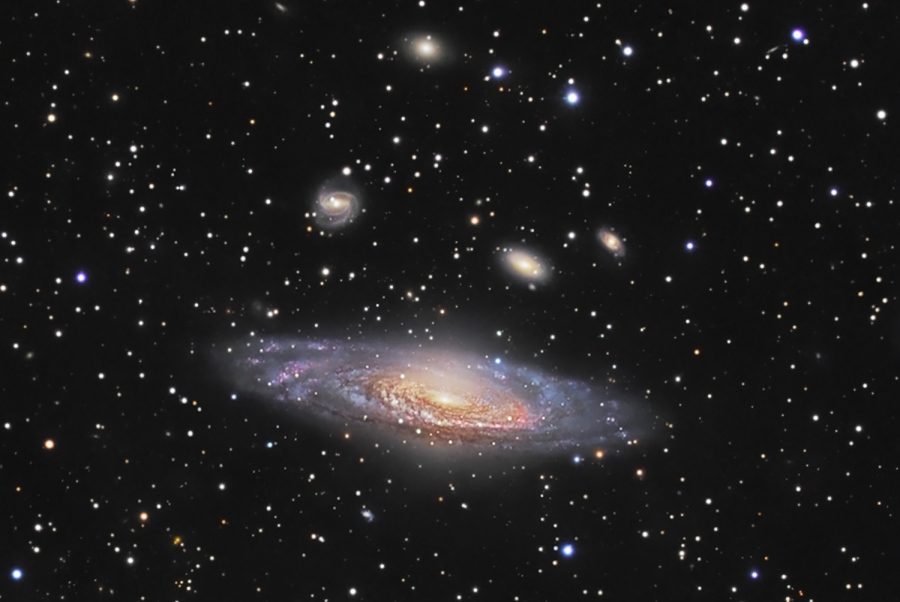 Big, beautiful spiral galaxy NGC 7331 is often touted as an analog to our own Milky Way. About 50 million light-years distant in the northern constellation Pegasus, NGC 7331 was recognized early on as a spiral nebula and is actually one of the brighter galaxies not included in Charles Messier's famous 18th century catalog. Since the galaxy's disk is inclined to our line-of-sight, long telescopic exposures often result in an image that evokes a strong sense of depth. The effect is further enhanced in this sharp image by galaxies that lie beyond the gorgeous island universe. The background galaxies are about one tenth the apparent size of NGC 7331 and so lie roughly ten times farther away. Their close alignment on the sky with NGC 7331 occurs just by chance. Seen here through faint foreground dust clouds lingering above the plane of Milky Way, this visual grouping of galaxies is also known as the Deer Lick Group.
__________________
1st in Kommisar's 2009 SM Tournament 1st in I Love You`s 2009 New Year`s Tournament 3rd in EnR's Mashfest '08 tournament 5th in Phynx's Unofficial FFR Tournament 9th in D3 of the 2008-2009 4th Official FFR Tournament 10th in D5 of the 2010 5th Official FFR Tournament 10th in D6 of the 2011-2012 6th Official FFR Tournament FMO AAA Count: 71 FGO AAA Count: 10 Bluearrowll = The Canadian player who can not detect awkward patterns. If it's awkward for most people, it's normal for Terry. If the file is difficult but super straight forward, he has issues. If he's AAAing a FGO but then heard that his favorite Hockey team was losing by a point, Hockey > FFR PS: Cool AAA's Terry - I Love You An Alarm Clock's Haiku beep beep beep beep beep beep beep beep beep beep beep beep beep beep beep beep beep - ieatyourlvllol |
|
|

|
|
|
#855 |
|
⊙▃⊙
|
Daily Suspicious0bserver's Weather Post:
March 2, 2014 What's in the sky tonight? March 2, 2014 -The 7th-magnitude asteroid 2 Pallas is now passing 3° east of Alphard in Hydra in the southeastern evening sky. -The face of the sun is peppered with spots. One of them in particular merits attention. AR1991 is rapidly growing, almost doubling its number of dark cores since yesterday. AR1991 has a 'beta-gamma' magnetic field that harbors energy for M-class solar flares. The rapid evolution of the sunspot could destabilize the field, making an eruption more likely. NOAA forecasters estimate a 70% chance of M-class flares and a 30% chance of X-flares on March 2nd. 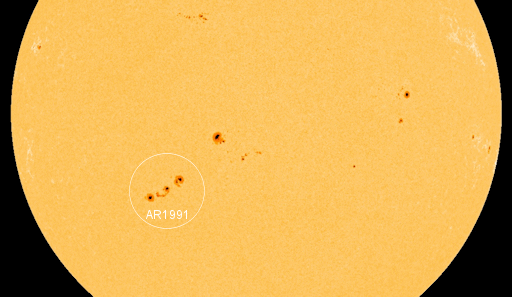 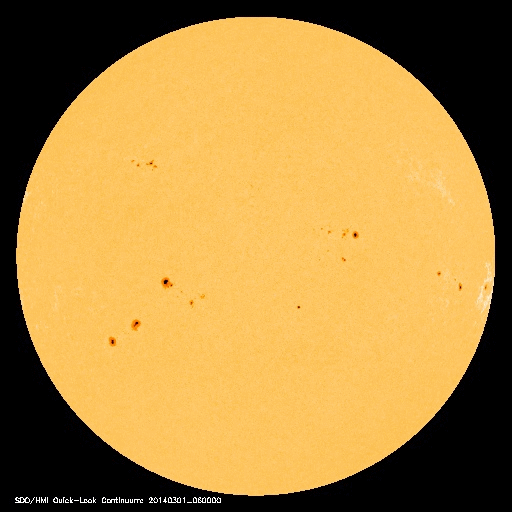 Astro Picture of the Day: March 2, 2014  What would it be like to see a sunset on Mars? To help find out, the robotic rover Spirit was deployed in 2005 to park and watch the Sun dip serenely below the distant lip of Gusev crater. Colors in the above image have been slightly exaggerated but would likely be apparent to a human explorer's eye. Fine martian dust particles suspended in the thin atmosphere lend the sky a reddish color, but the dust also scatters blue light in the forward direction, creating a bluish sky glow near the setting Sun. Because Mars is farther away, the Sun is less bright and only about two thirds the diameter it appears from Earth. Images like this help atmospheric scientists understand not only the atmosphere of Mars, but atmospheres across the Solar System, including our home Earth.
__________________
1st in Kommisar's 2009 SM Tournament 1st in I Love You`s 2009 New Year`s Tournament 3rd in EnR's Mashfest '08 tournament 5th in Phynx's Unofficial FFR Tournament 9th in D3 of the 2008-2009 4th Official FFR Tournament 10th in D5 of the 2010 5th Official FFR Tournament 10th in D6 of the 2011-2012 6th Official FFR Tournament FMO AAA Count: 71 FGO AAA Count: 10 Bluearrowll = The Canadian player who can not detect awkward patterns. If it's awkward for most people, it's normal for Terry. If the file is difficult but super straight forward, he has issues. If he's AAAing a FGO but then heard that his favorite Hockey team was losing by a point, Hockey > FFR PS: Cool AAA's Terry - I Love You An Alarm Clock's Haiku beep beep beep beep beep beep beep beep beep beep beep beep beep beep beep beep beep - ieatyourlvllol |
|
|

|
|
|
#856 |
|
⊙▃⊙
|
Daily Suspicious0bserver's Weather Post:
March 3, 2014 What's in the sky tonight? March 3, 2014 -Look high above the Moon in the west after dark for the stars of Aries hanging almost vertically. -Northern Lights are usually green, and sometimes red. Those are the colors produced by oxygen when it is excited by electrons raining down from space. On Feb. 22nd, Micha Bäuml of Straumfjord, Norway, witnessed an appariton of aurora-blue. "All of a sudden the sky exploded," says Micha. "The aurora looked like a giant flame." -In auroras, blue is a sign of nitrogen. Energetic particles striking ionized molecular nitrogen (N2+) at very high altitudes produces a cold azure glow of the type captured in Micha's photo. Why it overwhelmed the usual hues of oxygen on Feb 22nd is unknown. Auroras still have the capacity to surprise. -Any auroras tonight, blue or otherwise, will be a bit of a surprise. Geomagnetic conditions are quiet. NOAA forecasters estimate a scant 5% chance of polar geomagnetic storms on March 3rd. 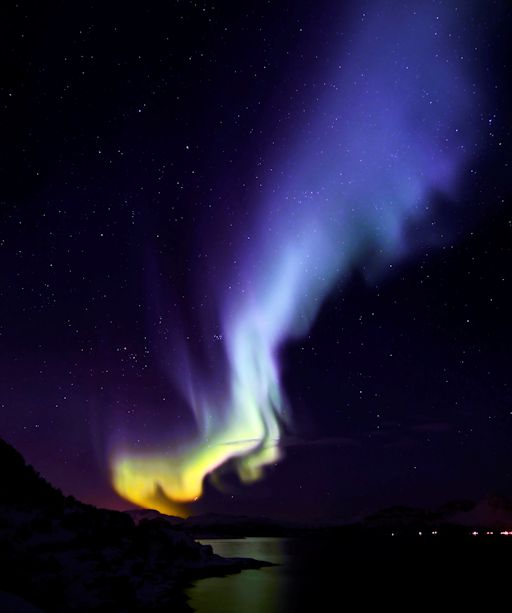 Astro Picture of the Day: March 3, 2014 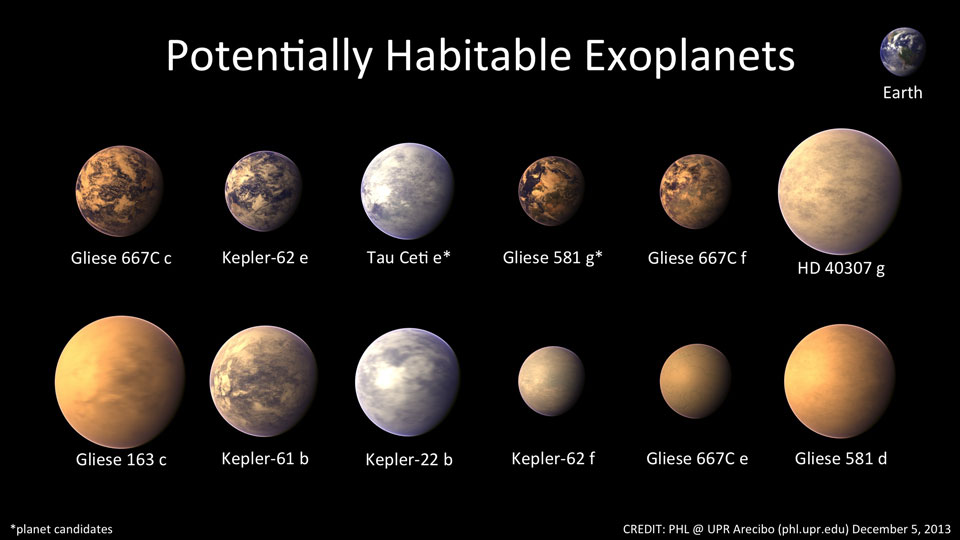 Is Earth the only known world that can support life? In an effort to find life-habitable worlds outside our Solar System, stars similar to our Sun are being monitored for slight light decreases that indicate eclipsing planets. Many previously-unknown planets are being found, including over 700 worlds recently uncovered by NASA's Kepler satellite. Depicted above in artist's illustrations are twelve extrasolar planets that orbit in the habitable zones of their parent stars. These exoplanets have the right temperature for water to be a liquid on their surfaces, and so water-based life on Earth might be able to survive on them. Although technology cannot yet detect resident life, finding habitable exoplanets is a step that helps humanity to better understand its place in the cosmos.
__________________
1st in Kommisar's 2009 SM Tournament 1st in I Love You`s 2009 New Year`s Tournament 3rd in EnR's Mashfest '08 tournament 5th in Phynx's Unofficial FFR Tournament 9th in D3 of the 2008-2009 4th Official FFR Tournament 10th in D5 of the 2010 5th Official FFR Tournament 10th in D6 of the 2011-2012 6th Official FFR Tournament FMO AAA Count: 71 FGO AAA Count: 10 Bluearrowll = The Canadian player who can not detect awkward patterns. If it's awkward for most people, it's normal for Terry. If the file is difficult but super straight forward, he has issues. If he's AAAing a FGO but then heard that his favorite Hockey team was losing by a point, Hockey > FFR PS: Cool AAA's Terry - I Love You An Alarm Clock's Haiku beep beep beep beep beep beep beep beep beep beep beep beep beep beep beep beep beep - ieatyourlvllol |
|
|

|
|
|
#857 |
|
⊙▃⊙
|
Daily Suspicious0bserver's Weather Post:
March 4, 2014 What's in the sky tonight? March 4, 2014 -Mars (magnitude –0.5, in Virgo) rises around 9 or 10 p.m., a fiery blaze 6° to the left of icy Spica. The two of them are highest in the south around 2 or 3 a.m., with Spica now lower right of Mars. -In a telescope Mars has grown to about 12 arcseconds wide, on its way to an apparent diameter of 15.1″ when it passes closest by Earth in mid-April. -On the night of March 3rd, with green lights swirling overhead, scientists at the University of Alaska's Poker Flat Research Range launched a 48-foot sounding rocket directly into the aurora borealis. "For weeks we've been sitting out all night every night, and though we've seen many good aurora, we haven't seen the type we wanted, in the position we wanted - until now," says graduate student Jason Ahrns, who took this picture of the rocket in flight. The rocket launch was part of a NASA-sponsored campaign called GREECE - short for "Ground-to-Rocket Electrodynamics-Electrons Correlative Experiment." Marilia Samara, a space scientist at the Southwest Research Institute in San Antonio, Texas, is the principal investigator. -GREECE aims to solve a long-standing mystery about auroras: Often, when a display begins, the lights are placid and widely spread across thousands of kilometers. Then, for reasons no one fully understands, the auroras will break up into highly-structured and rapidly changing arcs, swirls, curls, pillars, even "flames," with changes occurring on fraction-of-a-second time scales. Sensors on the Data from the sounding rocket will help researchers unravel the electrodynamics underlying these sudden and unpredictable transitions. "Preliminary expectations are that the launch was a total and complete success with lots of good science to come out of it," reports Ahrns. Updates on GREECE can be found here: http://greece.ssl.berkeley.edu/nightly-update/ 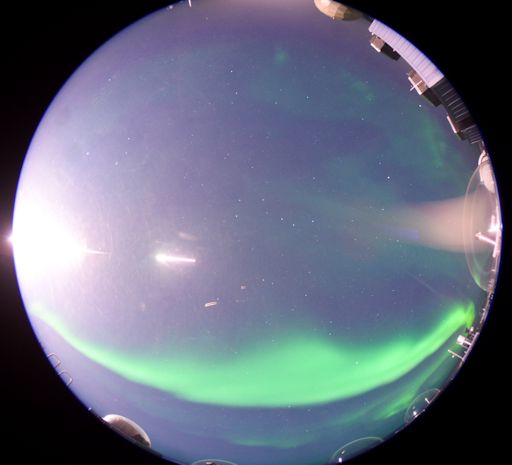 News Posted Today: February 28, 2014 New Record for Oldest Earth Rock  Astro Picture of the Day: March 4, 2014 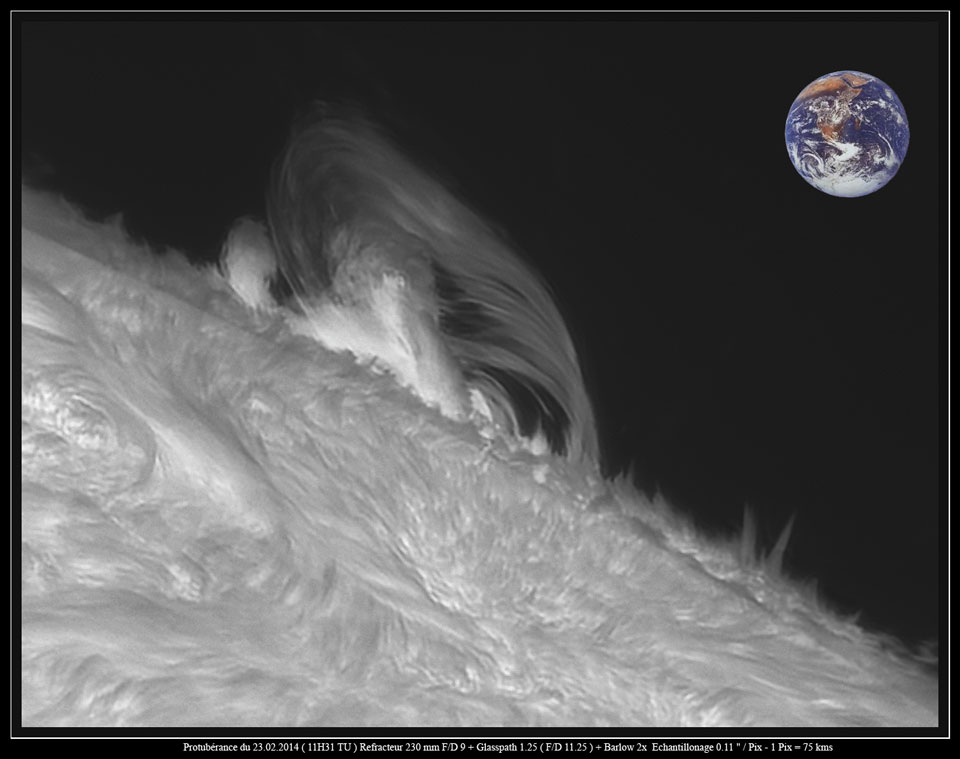 Dramatic prominences can sometimes be seen looming just beyond the edge of the sun. Such was the case last week as a large prominence, visible above, highlighted a highly active recent Sun. A waving sea of hot gas is visible in the foreground chromosphere in great detail as it was imaged in one specific color of light emitted by hydrogen. A solar prominence is a cloud of solar gas held just above the surface by the Sun's magnetic field. The Earth, illustrated in the inset, is smaller than the prominence. Although very hot, prominences typically appear dark when viewed against the Sun, since they are slightly cooler than the photosphere below them. A quiescent prominence typically lasts about a month, and may erupt in a Coronal Mass Ejection (CME) expelling hot gas into the Solar System, some of which may strike the Earth and trigger auroras.
__________________
1st in Kommisar's 2009 SM Tournament 1st in I Love You`s 2009 New Year`s Tournament 3rd in EnR's Mashfest '08 tournament 5th in Phynx's Unofficial FFR Tournament 9th in D3 of the 2008-2009 4th Official FFR Tournament 10th in D5 of the 2010 5th Official FFR Tournament 10th in D6 of the 2011-2012 6th Official FFR Tournament FMO AAA Count: 71 FGO AAA Count: 10 Bluearrowll = The Canadian player who can not detect awkward patterns. If it's awkward for most people, it's normal for Terry. If the file is difficult but super straight forward, he has issues. If he's AAAing a FGO but then heard that his favorite Hockey team was losing by a point, Hockey > FFR PS: Cool AAA's Terry - I Love You An Alarm Clock's Haiku beep beep beep beep beep beep beep beep beep beep beep beep beep beep beep beep beep - ieatyourlvllol |
|
|

|
|
|
#858 |
|
⊙▃⊙
|
Daily Suspicious0bserver's Weather Post:
March 5, 2014 What's in the sky tonight? March 5, 2014 -The huge "Winter Diamond" of 2014 stands upright in the south around 8 p.m. now. It's formed by Jupiter on top and Sirius on the bottom — the two brightest points in the evening sky — and Procyon forming its left corner and Betelgeuse as its right corner. -The lifespan of a typical sunspot is two to three weeks. This one is about to turn three months. Carried around by the sun's 27-day rotation, AR1990 is making its third transit of the visible solar disk. In previous apparitions it was known as AR1944 and AR1967. Each time it has appeared, the sunspot has unleashed at least one strong flare, the most recent being the X4.9-class blockbuster of Feb. 25th. Since then, AR1990 has quieted and started showing signs of decay. 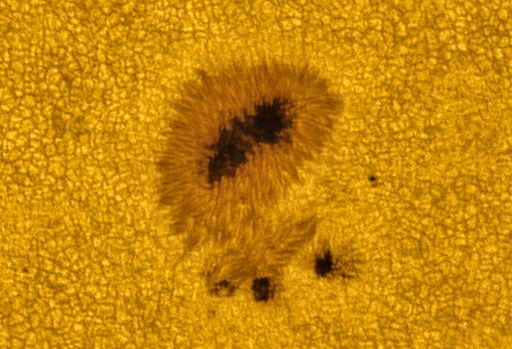 Astro Picture of the Day: March 5, 2014 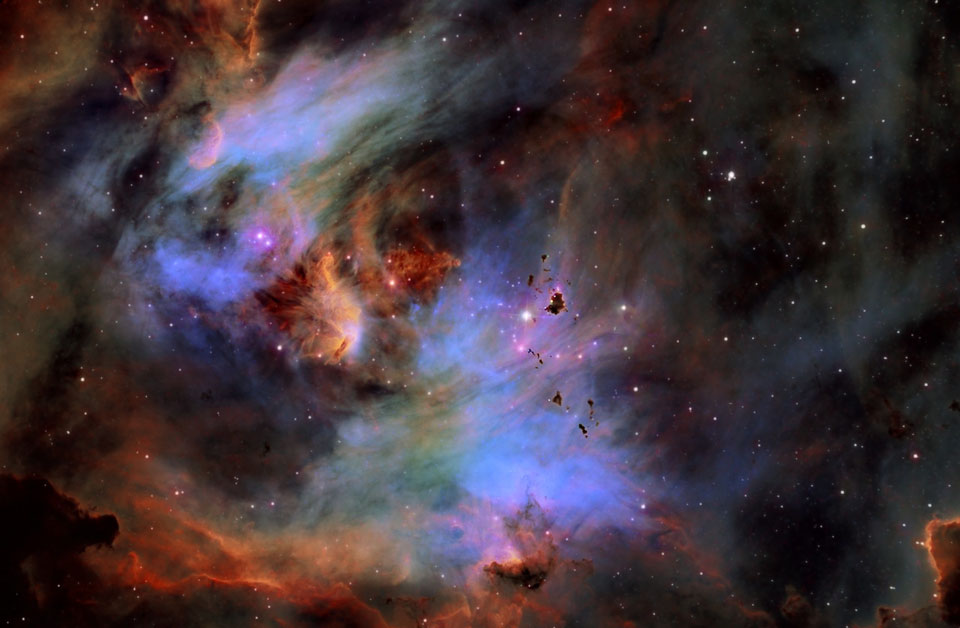 The eggs from this chicken may form into stars. The above pictured emission nebula, cataloged as IC 2944, is called the Running Chicken Nebula for the shape of its greater appearance. The image was taken recently from Siding Spring Observatory in Australia and presented in scientifically assigned colors. Seen near the center of the image are small, dark molecular clouds rich in obscuring cosmic dust. Called Thackeray's Globules for their discoverer, these "eggs" are potential sites for the gravitational condensation of new stars, although their fates are uncertain as they are also being rapidly eroded away by the intense radiation from nearby young stars. Together with patchy glowing gas and complex regions of reflecting dust, these massive and energetic stars form the open cluster Collinder 249. This gorgeous skyscape spans about 70 light-years at the nebula's estimated 6,000 light-year distance.
__________________
1st in Kommisar's 2009 SM Tournament 1st in I Love You`s 2009 New Year`s Tournament 3rd in EnR's Mashfest '08 tournament 5th in Phynx's Unofficial FFR Tournament 9th in D3 of the 2008-2009 4th Official FFR Tournament 10th in D5 of the 2010 5th Official FFR Tournament 10th in D6 of the 2011-2012 6th Official FFR Tournament FMO AAA Count: 71 FGO AAA Count: 10 Bluearrowll = The Canadian player who can not detect awkward patterns. If it's awkward for most people, it's normal for Terry. If the file is difficult but super straight forward, he has issues. If he's AAAing a FGO but then heard that his favorite Hockey team was losing by a point, Hockey > FFR PS: Cool AAA's Terry - I Love You An Alarm Clock's Haiku beep beep beep beep beep beep beep beep beep beep beep beep beep beep beep beep beep - ieatyourlvllol |
|
|

|
|
|
#859 |
|
⊙▃⊙
|
Daily Suspicious0bserver's Weather Post:
March 6, 2014 What's in the sky tonight? March 6, 2014 -After nightfall, look for Aldebaran to the upper left of the Moon and the Pleiades to the Moon's upper right, as shown below. -For the second time in as many days, an asteroid is flying through the Earth-Moon system. Yesterday, March 5th, 30-meter asteroid 2014 DX110 passed just inside the orbit of the Moon--about 0.9 lunar distances away. Today, March 6th, 10-meter asteroid 2014 EC is coming even closer--only 0.2 lunar distances. Neither space rock poses an immediate threat to Earth. According to NASA, asteroids thread the Earth-Moon system more than 20 times a year. -Hours ago, a bright coronal mass ejection (CME) flew over the sun's southeastern limb. If such an event had occured years ago, we wouldn't know if this CME was a threat because, as viewed from Earth orbit, CMEs heading toward and away from Earth look much the same. Today, however, all CMEs are observed from multiple points of view. Dual coronagraph images from SOHO (stationed on the Earthside of the sun) and the STEREO-A probe (stationed on the farside) clearly show that this CME is a farside event. Radio emissions from shock waves at the leading edge of the blast suggest the cloud is racing away from Earth at approximately 1400 km/s (3 million mph). If it were racing in the opposite direction, we would have a significant geomagnetic storm in the offing. Instead, space weather around Earth is expected to remain calm for the rest of this week.  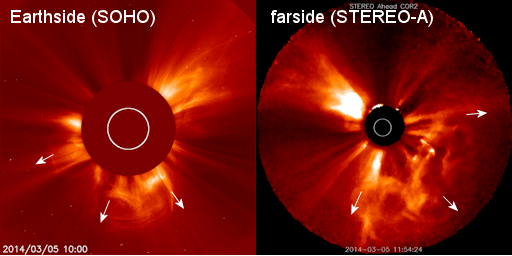 Astro Picture of the Day: March 6, 2014  NGC 1333 is seen in visible light as a reflection nebula, dominated by bluish hues characteristic of starlight reflected by dust. A mere 1,000 light-years distant toward the heroic constellation Perseus, it lies at the edge of a large, star-forming molecular cloud. This striking close-up view spans about two full moons on the sky or just over 15 light-years at the estimated distance of NGC 1333. It shows details of the dusty region along with hints of contrasting red emission from Herbig-Haro objects, jets and shocked glowing gas emanating from recently formed stars. In fact, NGC 1333 contains hundreds of stars less than a million years old, most still hidden from optical telescopes by the pervasive stardust. The chaotic environment may be similar to one in which our own Sun formed over 4.5 billion years ago.
__________________
1st in Kommisar's 2009 SM Tournament 1st in I Love You`s 2009 New Year`s Tournament 3rd in EnR's Mashfest '08 tournament 5th in Phynx's Unofficial FFR Tournament 9th in D3 of the 2008-2009 4th Official FFR Tournament 10th in D5 of the 2010 5th Official FFR Tournament 10th in D6 of the 2011-2012 6th Official FFR Tournament FMO AAA Count: 71 FGO AAA Count: 10 Bluearrowll = The Canadian player who can not detect awkward patterns. If it's awkward for most people, it's normal for Terry. If the file is difficult but super straight forward, he has issues. If he's AAAing a FGO but then heard that his favorite Hockey team was losing by a point, Hockey > FFR PS: Cool AAA's Terry - I Love You An Alarm Clock's Haiku beep beep beep beep beep beep beep beep beep beep beep beep beep beep beep beep beep - ieatyourlvllol |
|
|

|
|
|
#860 |
|
⊙▃⊙
|
Daily Suspicious0bserver's Weather Post:
March 7, 2014 What's in the sky tonight? March 7, 2014 -Look below the Moon this evening for orange Aldebaran, an orange giant star 65 light-years from Earth. Far off to their left is Betelgeuse in the top of Orion. Less far to their right are the Pleiades. -March 6th began with a bang. "Last night, here was a significant fireball over north central New Mexico at precisely 00:19:20 am MST," reports Thomas Ashcraft. "It was brighter than the full Moon and shook houses from its sonic boom." Ashcraft operates a fireball camera and forward-scatter meteor radar at his private observatory near Santa Fe. Turn up the volume and play the movie he recorded: http://www.spaceweather.com/images20...AshcraftSW.mp4 Approximately two hours later, a similar fireball streaked over Yellowknife, Canada, exploding so brightly that the flash turned the night sky blue: Yuichi Takasaka took the picture from the verge of Vee Lake. "I was leading an Aurora Photography Tour," says Takasaka. "We had quite colourful auroras all night. All of sudden at 02:13 local time, one shooting star started from Western sky and exploded towards North. It got so bright that I had to close my eyes like someone used electric flash in front of me. A few minutes later, we could hear the huge explosion from the direction of the fireball fell. What an exciting night!!!" As far as we know there is no conection between these two events or the asteroid 2014 EC, which flew past Earth on March 6th. They are probably random meteoroids of the type that strike Earth's atmosphere every night. -NASA's Hubble Space Telescope has recorded the never-before-seen break-up of an asteroid into as many as 10 smaller pieces. http://science.nasa.gov/science-news...6mar_asteroid/  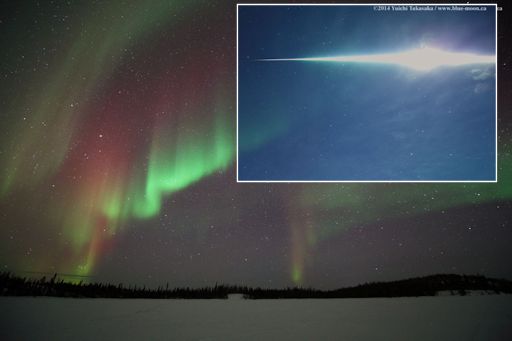 Astro Picture of the Day: March 7, 2014  Brilliant Venus and the central Milky Way rise in the early morning hours of March 1 in this sea and skyscape. The scene looks out from a beach at Sea Isle City, New Jersey, USA, planet Earth. Of course, Earth orbits well within the solar system's habitable zone, that Goldilocks region not too close and not too far from the Sun where surface temperatures can support liquid water. Similar in size to Earth, Venus lies just beyond the inner boundary of the habitable zone. The watery reflection of light from our inhospitable sister planet is seen along a calm, cold ocean and low cloud bank.
__________________
1st in Kommisar's 2009 SM Tournament 1st in I Love You`s 2009 New Year`s Tournament 3rd in EnR's Mashfest '08 tournament 5th in Phynx's Unofficial FFR Tournament 9th in D3 of the 2008-2009 4th Official FFR Tournament 10th in D5 of the 2010 5th Official FFR Tournament 10th in D6 of the 2011-2012 6th Official FFR Tournament FMO AAA Count: 71 FGO AAA Count: 10 Bluearrowll = The Canadian player who can not detect awkward patterns. If it's awkward for most people, it's normal for Terry. If the file is difficult but super straight forward, he has issues. If he's AAAing a FGO but then heard that his favorite Hockey team was losing by a point, Hockey > FFR PS: Cool AAA's Terry - I Love You An Alarm Clock's Haiku beep beep beep beep beep beep beep beep beep beep beep beep beep beep beep beep beep - ieatyourlvllol |
|
|

|
 |
| Currently Active Users Viewing This Thread: 1 (0 members and 1 guests) | |
|
|